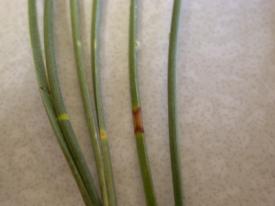

Dothistroma needle blight - showing early banding symptoms.
|
|
| Severity: | 4 out of 5 |
| Frequency: | 1 out of 5 |
| Symptoms: | Symptoms usually occur in early fall as yellow to tan needle spots and dark-green bands on needles that quickly turn brown to red. Needle tips die, leaving the needle base green. Needles may break off leaving a shredded greyish appearance (often describe as looking like a cigarette ash) or bend at a sharp angle at the infection site. Look for infection in the lower part of the tree first. |
| Cycle: | Time from infection to symptoms takes between 5 weeks to 6 months. Disease over winters on infected needles. Disease is spread by wind and water. Warm and wet weather is best for infection. Infection can occur throughout the growing season in the north central states on needles two or more years of age. Older needles may become infected from May to October (worse in Sept. & Oct.). New needles can become infected once they mature (infection can occur mid June to October). Early needle drop is common, but infected needles remaining on the tree are more important than fallen needles as a source of inoculum. Young trees are more susceptible than older trees. Fruiting structures develop in the dead tips in the fall and appear as black pinhead-sized spots. |
| Management: | Remove and destroy infected plant material and destroy evergreen clippings when pruning or shaping the trees. Cultural measures such as weed control and proper plant spacing help reduce disease incidence and spread by promoting rapid drying of needles. In Christmas tree plantations, shearing of wet trees can spread spores of this fungus. Registered fungicides can be used on a preventive basis, and usual recommendations suggest two sprays, once in mid-May and again when new needles are expanded. During wet years, additional later applications may be needed. Host resistance within Austrian and ponderosa pine species is now in development. |
| Associated trees: | |